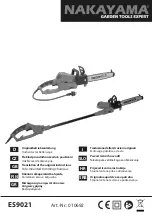
8
ENGLISH
The height difference between the toothed rim and the
lower end of the riving knife should be 2 - 3 mm.
Tighten the screws.
Fitting and removing the parallel fence (fig. C)
The parallel fence is used to saw in a straight line parellel
to the edge of the workpiece.
Fitting
Loosen the locking knob (18).
Insert the parallel fence (19) through the openings (20).
Slide the parallel fence into the desired position.
Tighten the locking knob.
Removing
Loosen the locking knob.
Pull the parallel fence off the tool.
Use
Warning!
Let the tool work at its own pace. Do not overload.
This tool can be used in the right hand or the left hand.
Adjusting the sawing angle (fig. D)
The default angle between the saw blade and the shoe is
90°.
Use a square to check that the angle between the saw
blade and the shoe is 90°. If the angle does not measure
90° adjust as follows:
Loosen the locking knob (21) to unlock the saw shoe.
Loosen the locknut (22) on the adjusting screw (23).
Screw the adjusting screw in or out to achieve a 90° angle.
Retighten the locknut.
Tighten the locking knob to lock the saw shoe in place.
Adjusting the depth of cut (fig. E)
The depth of cut should be set according to the thickness of
the workpiece. It should exceed the thickness by approx. 2 mm.
Loosen the knob (24) to unlock the saw shoe.
Move the saw shoe (8) into the desired position. The
corresponding depth of cut can be read from the scale (25).
Tighten the knob to lock the saw shoe in place.
Adjusting the bevel angle (fig. F)
This tool can be set to bevel angles between 0° and 45°.
Loosen the locking knob (21) to unlock the saw shoe.
Move the saw shoe (10) into the desired position. The
corresponding mitre angle can be read from the scale (26).
Tighten the locking knob to lock the saw shoe in place.
Switching on and off
To switch the tool on, move the lock-off button (2) into the
unlock position and squeeze the on/off switch (1).
To switch the tool off, release the on/off switch.
Sawing
Always hold the tool with both hands.
Let the blade run freely for a few seconds before starting
the cut.
Apply only a gentle pressure to the tool while performing
the cut.
Work with the shoe pressed against the workpiece.
Hints for optimum use
As some splintering along the line of cut on the top side of
the workpiece cannot be avoided, cut on the side where
splintering is acceptable.
Where splintering is to be minimised, e.g. when cutting
laminates, clamp a piece of plywood onto the top of the
workpiece.
Using the sight guide (fig. G)
The tool is equipped with a sight guide for straight cutting (27)
and for 45° bevel cutting (28).
Adjust the sight guide as described below.
Align the left edge of the guides (27) or (28) with the
cutting line (29).
Keep the sight guide aligned with the cutting line while
sawing.
Work with the shoe pressed against the workpiece.
Adjusting the sight guide
Make a test cut halfway through a piece of scrap wood.
Withdraw the saw so the cutting line (29) becomes visible.
While keeping the saw in this position, loosen the sight
guide on the saw shoe as shown.
Align the 0° mark (27) on the sight guide with the cutting
line (29). When adjusting for 45° bevel cuts, align the 45°
mark (28) on the sight guide with the cutting line.
Secure the sight guide using the screw (30).
How to use the laser (fig. H)
The laser projects the line of cut on the workpiece surface.
To switch the laser on, slide the switch (6) forward.
To switch the laser off, slide the switch (6) backward.
Viewing from directly above the saw, the line of cut can be
easily followed. Should this view be restricted for any reason,
the laser can be used as an alternate cutting guide.
Use a pencil to mark the cutting line.
Position the saw over the line.
Switch on the laser.
Summary of Contents for Powerful Solutions KS1400L
Page 2: ...2 A 14 13 15 16 9 B C D 17 11 19 20 18 23 22 21 ...
Page 3: ...3 E F G H 24 25 8 26 21 28 27 29 30 6 ...
Page 96: ...96 ...
Page 97: ...97 ...









































